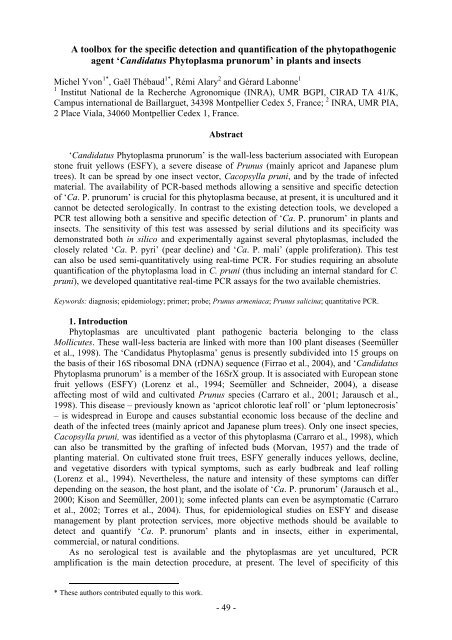Ecole Nationale Supérieure Agronomique de Montpellier ... - CIAM
Ecole Nationale Supérieure Agronomique de Montpellier ... - CIAM
Ecole Nationale Supérieure Agronomique de Montpellier ... - CIAM
Create successful ePaper yourself
Turn your PDF publications into a flip-book with our unique Google optimized e-Paper software.
A toolbox for the specific <strong>de</strong>tection and quantification of the phytopathogenic<br />
agent ‘Candidatus Phytoplasma prunorum’ in plants and insects<br />
Michel Yvon 1* , Gaël Thébaud 1* , Rémi Alary 2 and Gérard Labonne 1<br />
1 Institut National <strong>de</strong> la Recherche <strong>Agronomique</strong> (INRA), UMR BGPI, CIRAD TA 41/K,<br />
Campus international <strong>de</strong> Baillarguet, 34398 <strong>Montpellier</strong> Ce<strong>de</strong>x 5, France; 2 INRA, UMR PIA,<br />
2 Place Viala, 34060 <strong>Montpellier</strong> Ce<strong>de</strong>x 1, France.<br />
Abstract<br />
‘Candidatus Phytoplasma prunorum’ is the wall-less bacterium associated with European<br />
stone fruit yellows (ESFY), a severe disease of Prunus (mainly apricot and Japanese plum<br />
trees). It can be spread by one insect vector, Cacopsylla pruni, and by the tra<strong>de</strong> of infected<br />
material. The availability of PCR-based methods allowing a sensitive and specific <strong>de</strong>tection<br />
of ‘Ca. P. prunorum’ is crucial for this phytoplasma because, at present, it is uncultured and it<br />
cannot be <strong>de</strong>tected serologically. In contrast to the existing <strong>de</strong>tection tools, we <strong>de</strong>veloped a<br />
PCR test allowing both a sensitive and specific <strong>de</strong>tection of ‘Ca. P. prunorum’ in plants and<br />
insects. The sensitivity of this test was assessed by serial dilutions and its specificity was<br />
<strong>de</strong>monstrated both in silico and experimentally against several phytoplasmas, inclu<strong>de</strong>d the<br />
closely related ‘Ca. P. pyri’ (pear <strong>de</strong>cline) and ‘Ca. P. mali’ (apple proliferation). This test<br />
can also be used semi-quantitatively using real-time PCR. For studies requiring an absolute<br />
quantification of the phytoplasma load in C. pruni (thus including an internal standard for C.<br />
pruni), we <strong>de</strong>veloped quantitative real-time PCR assays for the two available chemistries.<br />
Keywords: diagnosis; epi<strong>de</strong>miology; primer; probe; Prunus armeniaca; Prunus salicina; quantitative PCR.<br />
1. Introduction<br />
Phytoplasmas are uncultivated plant pathogenic bacteria belonging to the class<br />
Mollicutes. These wall-less bacteria are linked with more than 100 plant diseases (Seemüller<br />
et al., 1998). The ‘Candidatus Phytoplasma’ genus is presently subdivi<strong>de</strong>d into 15 groups on<br />
the basis of their 16S ribosomal DNA (rDNA) sequence (Firrao et al., 2004), and ‘Candidatus<br />
Phytoplasma prunorum’ is a member of the 16SrX group. It is associated with European stone<br />
fruit yellows (ESFY) (Lorenz et al., 1994; Seemüller and Schnei<strong>de</strong>r, 2004), a disease<br />
affecting most of wild and cultivated Prunus species (Carraro et al., 2001; Jarausch et al.,<br />
1998). This disease – previously known as ‘apricot chlorotic leaf roll’ or ‘plum leptonecrosis’<br />
– is wi<strong>de</strong>spread in Europe and causes substantial economic loss because of the <strong>de</strong>cline and<br />
<strong>de</strong>ath of the infected trees (mainly apricot and Japanese plum trees). Only one insect species,<br />
Cacopsylla pruni, was i<strong>de</strong>ntified as a vector of this phytoplasma (Carraro et al., 1998), which<br />
can also be transmitted by the grafting of infected buds (Morvan, 1957) and the tra<strong>de</strong> of<br />
planting material. On cultivated stone fruit trees, ESFY generally induces yellows, <strong>de</strong>cline,<br />
and vegetative disor<strong>de</strong>rs with typical symptoms, such as early budbreak and leaf rolling<br />
(Lorenz et al., 1994). Nevertheless, the nature and intensity of these symptoms can differ<br />
<strong>de</strong>pending on the season, the host plant, and the isolate of ‘Ca. P. prunorum’ (Jarausch et al.,<br />
2000; Kison and Seemüller, 2001); some infected plants can even be asymptomatic (Carraro<br />
et al., 2002; Torres et al., 2004). Thus, for epi<strong>de</strong>miological studies on ESFY and disease<br />
management by plant protection services, more objective methods should be available to<br />
<strong>de</strong>tect and quantify ‘Ca. P. prunorum’ plants and in insects, either in experimental,<br />
commercial, or natural conditions.<br />
As no serological test is available and the phytoplasmas are yet uncultured, PCR<br />
amplification is the main <strong>de</strong>tection procedure, at present. The level of specificity of this<br />
* These authors contributed equally to this work.<br />
- 49 -



